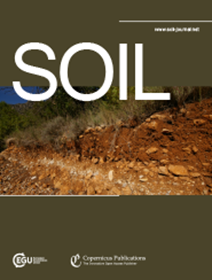溶解碳流向颗粒有机碳可增强土壤固碳能力
IF 5.8
2区 农林科学
Q1 SOIL SCIENCE
引用次数: 0
摘要
摘要。颗粒有机碳(POC)和矿物相关有机碳(MAOC)是土壤碳库的两种主要成分,它们具有不同的物理和化学性质以及生化周转率。微生物死亡后的沉积是快速腐烂的植物基质形成 MAOC 的主要机制,而 POC 通常被认为是结构性废弃物通过物理破碎形成的产物。然而,新出现的证据表明,从易腐烂的 C 基质中提取的微生物副产品可以进入 POC 库。迄今为止,人们仍不清楚溶解碳进入 POC 池的程度,以及它如何影响随后的长期土壤有机碳(SOC)储存。我们的研究通过对 5 个草地地点的 10 块土壤进行 13C 标记实验以及模型分析,发现在 POC 池中检测到了高达 12.29% 的同位素标记葡萄糖 C(即溶解 C)。此外,葡萄糖衍生的 POC 与 13C-MBC(微生物生物量碳)以及粘土和淤泥的比例相关,这表明溶解碳到 POC 的流动取决于土壤物理过程和微生物过程之间的相互作用。建模分析表明,忽略从 MBC 到 POC 的碳流,会大大低估土壤固碳量,在 10 种土壤中,低估率高达 53.52%。结果表明,除植物结构残留物外,由土壤矿物调节的微生物过程也是 POC 的重要贡献者,是 SOC 动态变化的重要组成部分。本文章由计算机程序翻译,如有差异,请以英文原文为准。
Dissolved carbon flow to particulate organic carbon enhances soil carbon sequestration
Abstract. Particulate organic carbon (POC) and mineral-associated organic carbon (MAOC), which are two primary components of the soil carbon (C) reservoir, have different physical and chemical properties as well as biochemical turnover rates. Microbial necromass entombment is a primary mechanism for MAOC formation from fast-decaying plant substrates, whereas POC is typically considered the product of structural litter via physical fragmentation. However, emerging evidence shows that microbial by-products derived from labile C substrates can enter the POC pool. To date, it is still unclear to what extent dissolved C can enter the POC pool and how it affects the subsequent long-term soil organic carbon (SOC) storage. Our study here, through a 13C-labeling experiment in 10 soils from 5 grassland sites as well as a modeling analysis, showed that up to 12.29 % of isotope-labeled glucose C (i.e., dissolved C) was detected in the POC pool. In addition, the glucose-derived POC was correlated with 13C-MBC (microbial biomass carbon) and the fraction of clay and silt, suggesting that the flow of dissolved C to POC is dependent on interactions between soil physical and microbial processes. The modeling analysis showed that ignoring the C flow from MBC to POC significantly underestimated soil C sequestration by up to 53.52 % across the 10 soils. The results emphasize that the soil mineral-regulated microbial process, besides the plant structural residues, is a significant contributor to POC, acting as a vital component in SOC dynamics.
求助全文
通过发布文献求助,成功后即可免费获取论文全文。
去求助
来源期刊

Soil
Agricultural and Biological Sciences-Soil Science
CiteScore
10.80
自引率
2.90%
发文量
44
审稿时长
30 weeks
期刊介绍:
SOIL is an international scientific journal dedicated to the publication and discussion of high-quality research in the field of soil system sciences.
SOIL is at the interface between the atmosphere, lithosphere, hydrosphere, and biosphere. SOIL publishes scientific research that contributes to understanding the soil system and its interaction with humans and the entire Earth system. The scope of the journal includes all topics that fall within the study of soil science as a discipline, with an emphasis on studies that integrate soil science with other sciences (hydrology, agronomy, socio-economics, health sciences, atmospheric sciences, etc.).
 求助内容:
求助内容: 应助结果提醒方式:
应助结果提醒方式:


